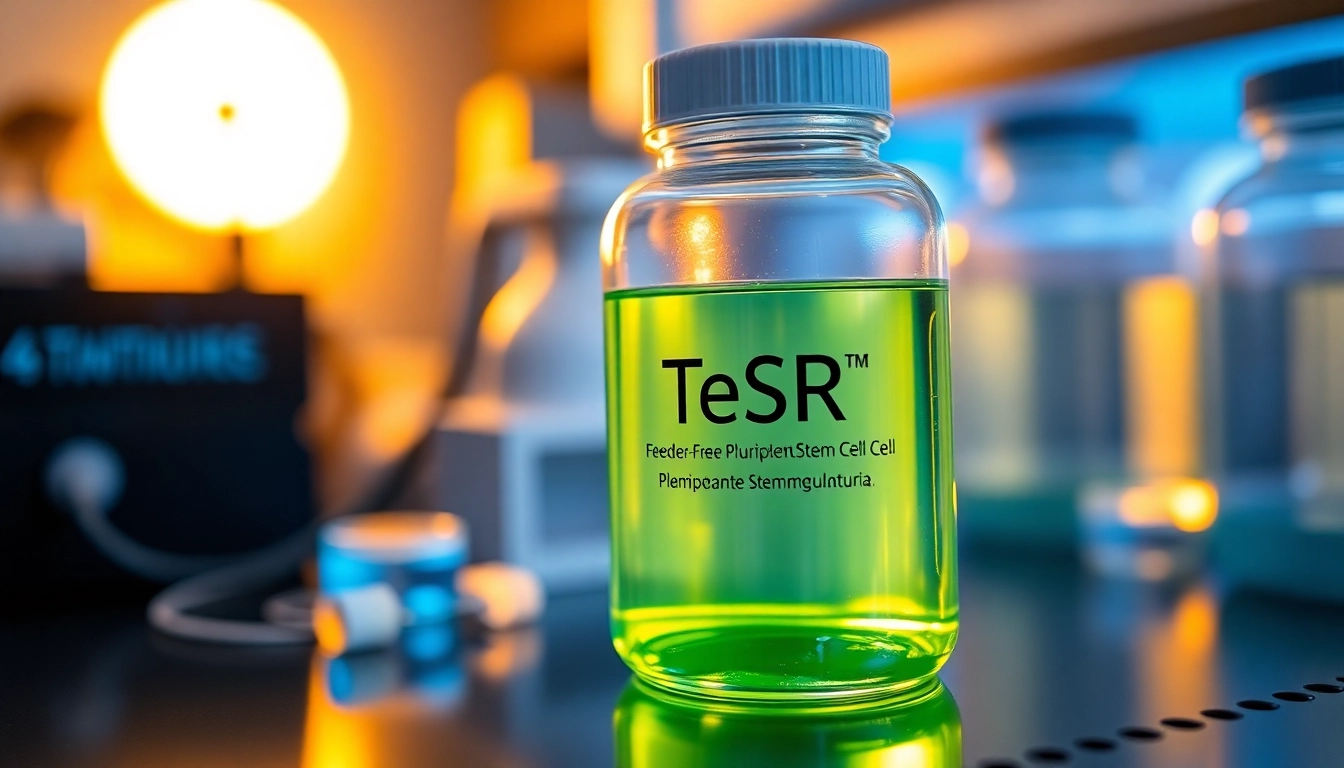Introduction to TeSR™ Feeder-Free Media
The advent of pluripotent stem cell (PSC) technologies has revolutionized biomedical research and therapeutic applications. Among the essential tools in this field are the TeSR™ family of feeder-free media, which enable the effective culture of human embryonic stem cells (hESCs) and induced pluripotent stem cells (iPSCs). The use of all check for these media offers researchers a range of formulations tailored for various applications, including maintenance, differentiation, and cryopreservation of PSCs.
Understanding Human Pluripotent Stem Cells
Human pluripotent stem cells (hPSCs) are characterized by their ability to self-renew and differentiate into any cell type in the human body. These cells hold significant promise for regenerative medicine, drug discovery, and disease modeling. The manipulation and study of hPSCs require optimized culture conditions to maintain their pluripotent characteristics, and the introduction of TeSR™ media has provided researchers with reliable and defined systems to achieve this.
Benefits of Feeder-Free Culture
Feeder-free culture systems, such as those provided by TeSR™, eliminate the need for animal-derived feeder layers, which can introduce variability and contamination risks. The benefits of feeder-free culturing include:
- Enhanced consistency and reproducibility: Defined compositions contribute to more reliable experimental outcomes.
- Increased safety: Minimizes biological contaminants that may arise from feeder layers.
- Improved scalability: Facilitates cell culture in suspension and bioreactor systems, essential for scaling up cellular therapies.
Overview of the TeSR™ Media Family
The TeSR™ media family features various formulations designed to cater to the distinct requirements of various applications involving human ES and iPS cells. Key products within this family include:
- mTeSR™ Plus: A maintenance medium designed for long-term culture of hPSCs with enhanced buffering capabilities.
- TeSR™-E8™: A low-protein medium that simplifies hPSC maintenance by containing only essential components.
- ReproTeSR™: Tailored for the reprogramming of somatic cells into iPSCs.
Applications of TeSR™ Media
Maintenance of Pluripotent Stem Cells
The primary application of TeSR™ media lies in the maintenance of pluripotent stem cells. The media are structured to support the self-renewal and pluripotency of these cells under defined conditions. For example, mTeSR™ Plus has been optimized to reduce medium acidification during skipped media changes, ensuring that cells maintain their quality and characteristics over extended periods.
Differentiation Pathways and Techniques
TeSR™ media also play a pivotal role in facilitating the differentiation of hPSCs into specific lineages. Various formulations support distinct differentiation pathways, including:
- TeSR™-E5 and TeSR™-E6: These media support the differentiation of hPSCs into definitive endoderm and other germ layers effectively.
- TeSR™-AOF: Animal origin-free media focused on differentiation applications while ensuring maximum safety against pathogens.
Many researchers have adopted protocols that include these media to achieve high reproducibility in differentiation assays, thereby enabling successful investigations into specific cell types and their related functionalities.
Cryopreservation Solutions
Cryopreservation is another essential aspect of stem cell culture, enabling the long-term storage of cells while preserving their viability and functionality. TeSR™ offers robust solutions such as:
- mFreSR™: A cryopreservation medium designed for maximum post-thaw recovery of hPSCs.
- FreSR™-S: Tailored for small-scale applications, this medium ensures optimal cell viability following thawing.
These solutions incorporate specific cryoprotectants and are formulated to support optimal cell recovery, making them indispensable for labs working with large numbers of stem cell lines.
Product Variations and Features
Comparing mTeSR™ Plus and Other Media
mTeSR™ Plus stands out among the TeSR™ media due to its advanced formulation that includes stabilized components such as FGF2. In addition to this, it features:
- Enhanced pH buffering: This results in reduced acidification of the medium, preserving cell health over longer culture periods.
- Extended culture times: Enables researchers to maintain cultures without routine media changes, which can be advantageous for high-throughput applications.
Key Ingredients and Their Functions
Each TeSR™ formulation consists of carefully chosen ingredients to facilitate optimal stem cell maintenance and differentiation. Key components often include:
- Growth factors: Such as FGF2 and TGF-β, which promote cell survival and proliferation.
- Basal media components: These may include essential amino acids, vitamins, and salts that support cellular metabolism.
- Cytokines: Critical for signaling pathways that maintain pluripotency or drive differentiation.
Understanding the role of these ingredients aids researchers in tailoring conditions suited for their specific experimental needs.
Stability and Shelf Life of Media Products
The stability and shelf life of stem cell media are crucial for reliable experimental outcomes. TeSR™ media are designed with rigorous quality control and stabilization techniques to ensure:
- Consistent performance: Through batch-to-batch testing, media provide expected results in hPSC culture and differentiation.
- Extended shelf life: Many formulations are stable for extended periods when stored under appropriate conditions, allowing flexibility in lab scheduling.
Expert Insights and Case Studies
Interviews with Renowned Researchers
In practical applications of TeSR™ media, various key opinion leaders have shed light on specific use cases and challenges in their research. Notable insights include:
- Dr. Joseph C. Wu: Emphasized the importance of using TeSR™ media for differentiating hematopoietic cells from pluripotent stem cells, highlighting reproducibility and efficiency in outcomes.
- Dr. Andrew Elefanty: Discussed how differentiation into definitive endoderm using TeSR™-E5 improved developmental consistency in his research.
- Dr. Robert Zweigerdt: Presented case studies demonstrating the effectiveness of TeSR™ media in generating cardiomyocytes, aligning with translational research goals for regenerative therapies.
Challenges in Cell Culture and Solutions
One of the prominent challenges faced in stem cell culture is ensuring the quality and consistency of proliferating cultures. Researchers identified several methods to mitigate these concerns:
- Implementing rigorous quality control: Continuous assessment of genomic integrity and pluripotency markers allows early detection of deviations.
- Optimizing culture conditions: Tailoring media formulations per experimental requirements can significantly influence outcomes.
Real-World Applications and Success Stories
Numerous laboratories worldwide have successfully utilized TeSR™ media in various applications, from basic research to advanced clinical trials. Success stories include:
- Collaboration with biotech firms: Companies engaged in cell therapies have leveraged TeSR™ media to develop scalable production processes for therapeutic cells.
- Academic research publications: Over 1100 studies have cited mTeSR™1 alone, underscoring its broad acceptance and efficacy in the scientific community.
Quality Assurance and Regulatory Compliance
Quality Control Measures in Media Production
STEMCELL Technologies employs stringent quality control measures throughout the production of TeSR™ media. Key practices include:
- Batch testing: Each batch undergoes comprehensive tests to ensure it meets predefined specifications for performance.
- Standard operating procedures: Strict adherence to protocols ensures that all products remain consistent and reliable.
Understanding cGMP Standards
Current Good Manufacturing Practices (cGMP) are vital in the production of stem cell culture media, especially those intended for clinical use. These standards ensure:
- Safety: Products are manufactured in controlled environments, reducing the risk of contamination.
- Efficacy: Compliance ensures that the media perform as expected in regulated environments.
Impact of Regulatory Guidelines on Research
The evolving landscape of regulations surrounding stem cell research necessitates that researchers remain vigilant regarding compliance. Adhering to guidelines enhances credibility, facilitates grant funding, and accelerates the path to clinical applications.



